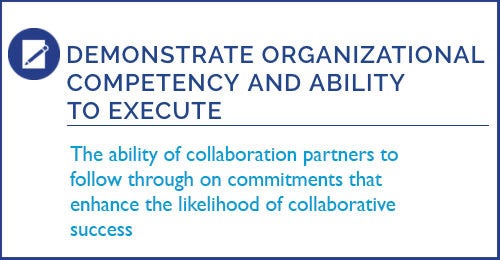May 23 2017 Diving Into The Intersector Toolkit: Demonstrate Organizational Competency and Ability to Execute
 We recently updated our Toolkit for Intersector Collaboration to provide even more useful advice to practitioners involved in cross-sector collaborations. We’re profiling each of our 17 tools on our blog, with a focus on resources that can help collaborations succeed.
We recently updated our Toolkit for Intersector Collaboration to provide even more useful advice to practitioners involved in cross-sector collaborations. We’re profiling each of our 17 tools on our blog, with a focus on resources that can help collaborations succeed.
Cross-sector collaboration often requires partners to work in contexts that differ from their day-to-day operating environment, which can be a challenge. But partners’ ability to follow through on commitments — what we refer to in our Toolkit as Demonstrate Organizational Competency and Ability to Execute — inspires trust among partners and external stakeholders, building confidence in the collaboration and increasing the likelihood of success. If partners are unable to fulfill commitments, progress may stall, and confidence in and commitment to the collaboration may wane.
The collaboration can hold partners accountable for their commitments by: identifying clear expectations for each partner and establishing time lines for these expectations, ensuring all partners understand and mutually agree to these expectations and timelines (perhaps through a partnership agreement or memorandum of understanding), and consistently communicating the fulfillment of commitments among partners.
The University of Wisconsin Cooperative Extension’s “Evaluating Collaboratives: Reaching the Potential” includes several resources that can help ensure partners are following through with assigned tasks — particularly the Minutes of Meeting template, Collaborative Monitoring Chart, and Collaborative Management and Responsibility Chart, found on pp. 100-102. The Minutes of Meeting template allows the collaboration to record tasks, the responsible party for those tasks, and the timeline for their completion. The Collaborative Monitoring Chart provides a template for capturing collaboration activities, including a number of tasks completed on time, and could easily be adapted to allow for greater specificity in listing types of tasks or commitments completed each month. The Responsibility Chart provides a template for recording partner commitments and tracking follow through.
Tool 11: Ensuring Accountability, found on pp. 58-62 in Collaboration Roundtable’s “The Partnership Toolkit,” guides partners through processes that encourage them to take responsibility for their commitments, both as partners and as a collaborative team. This resource lists and describes five principles of effective accountability (clear roles and responsibilities, clear and realistic expectations, expectations balanced with resources, credible reporting, and reasonable adjustment) and offers means of reporting accountability — through regular progress reports; monthly, quarterly, or annual financial reports; a year end (or project end) report on activities, accomplishments, and shortcomings including a section on what should be done differently to improve the situation in the future; and client satisfaction surveys. While some of the exercises are aimed at assessing the ability of the collaboration as a whole to follow through on its commitments, they could easily be adapted for individual partners.
See Demonstrate Organizational Competency and Ability to Execute in our Toolkit for further discussion on this topic, questions to guide tool use, and more.
Explore the full Toolkit and each of the 17 tools with enhanced discussion, questions to guide tool use, and additional resources here.
